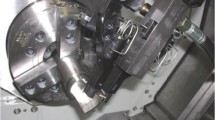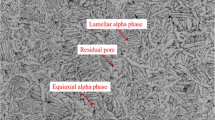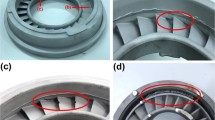Abstract
Titanium hollow blade is applied in aircraft turbo-machine to gain higher thrust-to-weight ratio. The typical combined superplastic forming and diffusion bonding (SPF/DB) technology has been widely used in manufacturing complex multi-layer hollow structures such as the titanium hollow blade. This study introduced a TC4 hollow blade with internal reinforcing ribs fabricated with a series of hot forming operations including diffusion bonding, hot twisting, stamping and gas bulging. During the forming process, the blade outer surface will sink at the cavity locations due to lack of internal support. The gas pressure bulging process is necessary to repair the defect and bulge the caved surface to the required profile. In order to predict the TC4 blade deformation during the SPF/DB process, its hot flow behavior in the DB and SPF were separately investigated by carrying out isothermal tensile tests at corresponding temperature range and strain rate range. And taking the initial microstructure influence in consideration, samples which experienced the DB heating history were used to characterize the flow behavior in the SPF processes. A strain hardening form power law equation and a hyperbolic-sine law equation were employed to describe the constitutive relations during the DB and SPF respectively. Both models were calibrated with the hot flow curves and applied in the corresponding forming step finite element (FE) simulations. The blade outer surface profiles extracted from each forming step simulation showed good correlation with the experimental measurement. It proved that the hollow blade surface sinkage defect during the SPF/DB process can be accurately predicted by the FE simulation with the calibrated constitutive models. And the effectiveness of the gas bulging process for repairing the sinkage defect were verified in both simulation and experiment.






























Similar content being viewed by others
References
Porter D, Dillner JR, Leibfried PE, Reimels WR, Asfalg GJ (1991) Method of forming a hollow blade. US Patent No. 5063662. U.S. Patent and Trademark Office, Washington, DC
Xun YW, Tan MJ (2000) Applications of superplastic forming and diffusion bonding to hollow engine blades. J Mater Process Technol 99(1-3):80–85. https://doi.org/10.1016/S0924-0136(99)00377-5
Zh Z, Xu J, Fu Y, Li Z (2017) An investigation on adaptively machining the leading and tailing edges of an SPF/DB titanium hollow blade using free-form deformation. Chin J Aeronaut 31(1):178–186. https://doi.org/10.1016/j.cja.2017.03.011
Ermachenko AG, Lutfullin RY, Mulyukov RR (2011) Advanced technologies of processing titanium alloys and their applications in industry. Rev Adv Mater Sci 29:68–821
Mavromihales M, Mason J, Weston W (2003) A case of reverse engineering for the manufacture of wide chord fan blades (WCFB) used in rolls Royce aero engines. J Mater Process Technol 134(3):279–286. https://doi.org/10.1016/S0924-0136(02)01108-1
Bichon M, Douguet CJP, Lorieux AGH, Louesdon YMJ, Renou, FAN (1997) Process for manufacturing a hollow blade for a turbo-machine. US Patent No. 5636440. U.S. Patent and Trademark Office, Washington, DC
Bing Z, Zhiqiang L, Hongliang H, Jinhua L, Bingzhe B (2010) Three dimensional FEM simulation of titanium hollow blade forming process. Rare Metal Mater Eng 39(6):963–968. https://doi.org/10.1016/S1875-5372(10)60106-3
Sun S, Zong Y, Shan D, Guo B (2010) Hot deformation behavior and microstructure evolution of TC4 titanium alloy. Trans Nonferrous Metals Soc China 20(11):2181–2184. https://doi.org/10.1016/S1003-6326(09)60439-8
Momeni A, Abbasi SM (2010) Effect of hot working on flow behavior of Ti-6Al-4V alloy in single phase and two phase regions. Mater Des 31(8):3599–3604. https://doi.org/10.1016/j.matdes.2010.01.060
Shafaat MA, Omidvar H, Fallah B (2011) Prediction of hot compression flow curves of Ti-6Al-4V alloy in α+β phase region. Mater Des 32(10):4689–4695. https://doi.org/10.1016/j.matdes.2011.06.048
Bai Q, Lin J, Dean TA, Balint DS, Gao T, Zhang Z (2013) Modelling of dominant softening mechanisms for Ti-6Al-4V in steady state hot forming conditions. Mater Sci Eng A 559:352–358. https://doi.org/10.1016/j.msea.2012.08.110
Zhang T, Liu Y, Sanders DG, Liu B, Zhang W, Zhou C (2014) Development of fine-grain size titanium 6Al-4V alloy sheet material for low temperature superplastic forming. Mater Sci Eng A 608:265–272. https://doi.org/10.1016/j.msea.2014.04.098
Quan GZ, Luo GC, Liang JT, Wu DS, Mao A, Liu Q (2015) Modelling for the dynamic recrystallization evolution of Ti-6Al-4V alloy in two-phase temperature range and a wide strain rate range. Comput Mater Sci 97:136–147. https://doi.org/10.1016/j.commatsci.2014.10.009
Quan GZ, Pan J, hua ZZ (2016) Phase transformation and recrystallization kinetics in space-time domain during isothermal compressions for Ti-6Al-4V analyzed by multi-field and multi-scale coupling FEM. Mater Des 94:523–535. https://doi.org/10.1016/j.matdes.2016.01.068
Tao ZJ, Yang H, Li H, Ma J, Gao PF (2016) Constitutive modeling of compression behavior of TC4 tube based on modified Arrhenius and artificial neural network models. Rare Metals 35(2):162–171. https://doi.org/10.1007/s12598-015-0620-4
Velay V, Matsumoto H, Vidal V, Chiba A (2016) Behavior modeling and microstructural evolutions of Ti-6Al-4V alloy under hot forming conditions. Int J Mech Sci 108–109:1–13. https://doi.org/10.1016/j.ijmecsci.2016.01.024
Luo J, Ye P, Li MQ, Liu LY (2015) Effect of the alpha grain size on the deformation behavior during isothermal compression of Ti-6Al-4V alloy. Mater Des 88:32–40. https://doi.org/10.1016/j.matdes.2015.08.130
Wu XC, Chen MH, Xie LS, Zhang TL, Hu ZH (2015) Twist-bend forming of aeroengine titanium tc4 wide-chord hollow fan blade with complex geometries. Acta Aeronaut Astronaut Sin 36(6):2055–2063 (In Chinese)
Wu XC, Chen MH, Xie LS, Zhang TL, Hu ZH (2016) Creep repair of skin defects for the titanium TC4 wide-chord hollow fan blade. Rare Metal Mater Eng 45(11):190–195 (In Chinese)
Davenport SB, Higginson RL, Sellars CM et al (1999) The effect of strain path on material behaviour during hot rolling of FCC metals. Mater Design 66:1645–1661. https://doi.org/10.1016/j.matdes.2014.05.045
Tuninetti V, Gilles G, Milis O, Pardoen T, Habraken AM (2015) Anisotropy and tension-compression asymmetry modeling of the room temperature plastic response of Ti-6Al-4V. Int J Plast 67:53–68. https://doi.org/10.1016/j.ijplas.2014.10.003
Matsumoto H, Velay V, Chiba A (2015) Flow behavior and microstructure in Ti-6Al-4V alloy with an ultrafine-grained α-single phase microstructure during low-temperature-high-strain-rate superplasticity. Mater Des 66:611–617. https://doi.org/10.1016/j.matdes.2014.05.045
Jiang SS, Zhang KF (2009) Superplastic forming of Ti6Al4V alloy using ZrO2-TiO2 ceramic die with adjustable linear thermal expansion coefficient. Philos T Roy Soc A 357:1645–1661
Xie HJ, Wu XC, Min YA (2008) Influence of chemical composition on phase transformation temperature and thermal expansion coefficient of hot work die steel. J Iron Steel Res Int 15(6):56–61
Ilinich A, Luckey SG (2014) On Modeling the Hot Stamping of High Strength Aluminum Sheet. SAE Technical Paper 2014-01-0983. https://doi.org/10.4271/2014-01-0983
Acknowledgements
This research was supported by the Postgraduate Research & Practice Innovation Program of Jiangsu Province (Grant No. KYLX_0313).
Author information
Authors and Affiliations
Corresponding author
Ethics declarations
Conflict of interest
The authors declared that they have no conflicts of interest to this work.
Additional information
Publisher’s Note
Springer Nature remains neutral with regard to jurisdictional claims in published maps and institutional affiliations.
Rights and permissions
About this article
Cite this article
Wang, N., Chen, M. & Xie, L. Hot flow behavior characterization for predicting the titanium alloy TC4 hollow blade surface Sinkage defects in the SPF/DB process. Int J Mater Form 12, 827–844 (2019). https://doi.org/10.1007/s12289-018-1454-z
Received:
Accepted:
Published:
Issue Date:
DOI: https://doi.org/10.1007/s12289-018-1454-z




